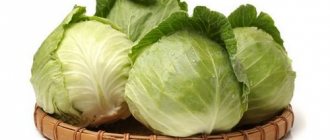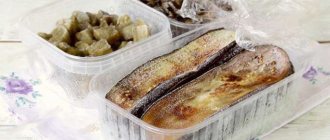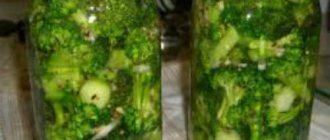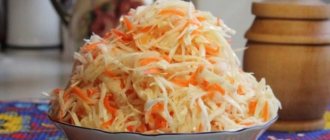How to choose broccoli
The maximum amount of vitamins and nutrients is contained in mature broccoli. Such heads of cabbage have a rich green or blue-violet hue, so when choosing, you need to pay attention to dark varieties. Light green varieties are most often early ripening; they also contain useful components, but in smaller quantities. Cabbage of these types does not store well in the freezer, so it is not worth using it to prepare semi-finished products for the winter.
Attention! A light green color may indicate that the vegetable has not ripened naturally and was removed from the garden early.
A vegetable is considered overripe when its inflorescences turn yellow. This product does not cause harm to the human body, but it is not beneficial either. Taste characteristics are also reduced. Varieties that ripen in the cold season, in late autumn, starting in October, have special nutritional value. Asparagus cabbage cut in summer may not reach the required degree of maturity, and therefore will not be as juicy and tender.
Advantages of the method
Is it possible to freeze broccoli for the winter? It is more convenient to store frozen foods for the winter; they are always at hand , saving time and the family budget. You can learn about other ways to store broccoli, as well as how to dry cabbage for the winter at home, from our articles.
Anything can be frozen, and broccoli is no exception; the most important thing is that the freezing process is carried out correctly .
Frozen broccoli: good or bad? Properly frozen broccoli retains the beneficial properties and taste of fresh cabbage.
General shelf life of broccoli in the refrigerator and freezer
This cabbage will bring maximum benefit to the human body only if its storage conditions are strictly observed. So, if you plan to eat a vegetable within 1 week, you should not freeze the product. Under the influence of low temperatures, it will lose some of its beneficial qualities. Freezing broccoli, in turn, is the optimal solution for storing the vegetable fresh and blanched for six months.
Attention! Ordinary white cabbage, especially late-ripening cabbage, is well stored during the winter in glassed-in loggias or in a cellar, but broccoli should not be stored this way. It may retain its appearance for several months when refrigerated, but the taste will be irrevocably altered.
The optimal shelf life of broccoli, depending on the conditions provided, is presented in the table.
| Storage method | Recommended period |
| In the refrigerator compartment, in a layer of water | About 10 days |
| In the refrigerator without water | No more than 5 days |
| In the freezer | About 6 months |
| In the cellar | From 2 weeks to 3 months (depending on conditions) |
The most profitable option, ensuring the longest possible storage in the refrigerator, is to place a forkful of cabbage in water. This method allows you to preserve the freshness of cabbage and does not lead to a change in its structure. If all conditions are met, the beneficial properties will also be preserved.
Step-by-step recipe for freezing broccoli
Parboiling destroys a special substance found in broccoli. This property prevents the preservation of smell and taste after defrosting. After the cabbage has undergone heat treatment, it is dried, the inflorescences are laid out on a dry waffle towel, and they are allowed to dry a little.
Freezing in portions provides convenience in the future, since the product cannot be re-frozen.
A large volume of boiled cabbage is divided into parts ranging from 250 to 300 grams. To prepare homemade culinary dishes, they usually take vegetables prepared in parts and divide them into portions.
Ziploc bags are very convenient to freeze. They are made of dense transparent material, come in various sizes, do not allow air to pass through after closing and are the best option for packaging frozen vegetables and fruits. In the absence of special packaging bags, they take ordinary plastic bags, from which, as far as possible, remove all the air and only then tie them into a knot.
Freezing broccoli in bags
After all the preparatory procedures for cleaning, scalding and drying, the inflorescences are placed in bags, on which, for convenience, an appropriate inscription is made, indicating the date. The packaging is placed in the free compartment of the freezer for pre-freezing. Only after a few hours, when the product is thoroughly frozen, the packaged broccoli is stacked on top of each other in a permanent storage location.
How to store broccoli in the refrigerator
In order for a product to be stored well in the refrigerator, it needs to be provided with a favorable temperature. Optimal indicators range from +10 to +5 degrees, in conditions of high air humidity. If the head of cabbage is freshly harvested, it can retain its qualities for 2 weeks.
There are several options that ensure high-quality storage of cabbage in the refrigerator:
- The cabbage is wrapped in a perforated plastic bag or cling film and then dipped in a container of water. The inflorescences should be located on top, and there should be little liquid in the vessel. The water needs to be changed every day, then the product will retain its freshness for 10 days.
- The broccoli is wrapped in a paper towel and then the resulting bundle is sprayed with a spray bottle. Place for storage in a container for vegetables. If this condition is met, the product will retain its quality for 1 week.
- Broccoli is divided into inflorescences and wrapped in small portions in cling film, and then sent to the bottom shelf of the refrigerator. The shelf life of the product is no more than 4 days.
Under the influence of moisture, the shelf life of the product is significantly reduced, because the processes of rotting and deterioration proceed much faster. Due to this feature, you should not wash broccoli before placing it in the refrigerator. If the fork is very dusty, it should be thoroughly dried before storing.
Safe proximity to other vegetables is an equally important criterion that allows you to preserve the freshness of the product longer. Broccoli should not be placed near foods that emit ethylene. This feature is distinguished not only by vegetables, but also by fruits, namely: apples, pears, carrots, tomatoes.
If the listed rules for storing broccoli at home are not followed, the inflorescences may turn yellow prematurely. Such a change indicates that the cabbage has deteriorated and should not be used for cooking. Most likely, the taste and beneficial properties are lost. You should not store broccoli in the refrigerator longer than the allotted expiration date, as the product will lose its positive qualities.
How and why to pre-blanch
Blanching is a matter of taste for every housewife. This is not a necessary step in preparing vegetables, but it has some advantages:
- Broccoli that has undergone preliminary heat treatment retains its taste and aroma better.
- Vegetable vitamins are also not destroyed when blanching is carried out correctly.
- After defrosting, cabbage is crispy and does not change its structure.
- Blanching gets rid of microorganisms that shorten the shelf life of the product. In addition, after processing, the amount of harmful chemicals used in growing vegetables is reduced.
The process of cooking broccoli can be carried out in a regular saucepan or steamer, if such equipment is available in the kitchen.
In a saucepan
For blanching, take a large-volume enamel-coated pan (about 5 liters minimum). Fill a container with cold water and put it on fire. Experienced housewives who have repeatedly carried out this procedure advise adding a little citric acid to the water for blanching broccoli (2 tsp per 2 liters of liquid). This will help maintain the bright green color of the cabbage, which will not disappear even after defrosting.
As soon as the water in the pan boils, lower the cabbage inflorescences into it in a colander. You cannot boil broccoli for more than 1 minute, this will lead to loss of structure and destruction of the bulk of vitamins and microelements. After this, immediately place the colander with the inflorescences under ice-cold running water, hold for 15 seconds and let the cabbage drain. Then spread it on a towel in a thin layer and allow the vegetable to dry.
There is another method in which blanching occurs under the influence of steam rather than boiling water. Pour cabbage inflorescences into a colander and place it over a pan of boiling water. Be sure to cover the top with a lid. Keep for 2 minutes and place the broccoli under cold water and on a towel to dry.
See also
How to properly freeze eggplants fresh for the winter in the freezer, shelf life
Read
In a steamer
Having such a household appliance in the kitchen can significantly reduce the time and labor spent preparing vegetables for freezing. The prepared cabbage inflorescences are placed in a steamer basket and steamed for 3 minutes. After this, be sure to rinse with ice water and dry on a towel.
Freezing for long-term storage
To keep broccoli fresh until the next harvest, it is better to freeze the vegetable. For this purpose, late-ripening varieties that have a dense structure and bright green color are used. For long-term storage, vegetables with a large central inflorescence are used. There should be no brown colors or any damage on its surface. Spoiled vegetables are not suitable for long-term storage. It is better to buy cabbage during the natural ripening season. Between August and September.
Freezing broccoli is a lengthy but not labor-intensive process that does not require skill or special skills. The housewife should simply carry out the processes according to the given algorithm:
- Vegetables are cleaned of soil and dust and must be washed under running water. This is an important point because broccoli must be cooked immediately after being removed from the freezer.
- To get rid of various insects that may be in the inflorescences, the cabbage is soaked in a saline solution for 30-60 minutes. The parasites will die and float to the surface.
- Broccoli is washed again and the leaves are removed.
- The vegetable is divided into inflorescences so that their diameter does not exceed 2-3 cm. If the central shoot is too large, it is cut into several parts.
- The trunk is cut into small pieces, and the hard part of the stem is thrown away.
Helpful advice! To ensure that the bright green color is preserved after freezing, before freezing, the cabbage must be soaked in a solution of citric acid or lemon juice for 5-7 minutes.
The mass of cabbage required for one-time use should be calculated and the product packaged in separate bags. Broccoli, like many other vegetables, does not tolerate re-freezing and loses its color and shape after thawing. The packages need to be marked; the note should indicate the date of freezing and weight, as well as the method of preliminary heat treatment.
With pre-heat treatment
Before freezing, cabbage must be subjected to heat treatment. The vegetable is blanched or steamed until half cooked. When exposed to heat, enzymes in broccoli are destroyed that can lead to spoilage of the product, so processed cabbage is stored in the freezer longer.
The work is carried out according to the following algorithm:
- the prepared cabbage is placed in a colander and immersed in boiling water for 5-10 seconds;
- the process is repeated 3 times;
- lay the vegetable on a clean towel and wait until it dries completely;
- Packed in bags in the required volume and placed in the freezer.
The duration of cooking in a double boiler is 10 minutes, during which time the half-cooked state will be reached.
No heat treatment
You should not freeze broccoli without first blanching it. If they remain in the freezer for a long time, the cabbage inflorescences will turn into dust and completely lose their structure. You should not worry too much about the fact that the vegetable will lose its taste; heat treatment enhances it.
For use in baby food
If you plan to use broccoli as a baby food product, it should be frozen as a puree. The preparation is made according to the following algorithm:
- the product is separated into individual inflorescences;
- rinse well under running water;
- place a pan of drinking water on the stove and add a little salt;
- after boiling, lower the inflorescences and cook them over low heat under a closed lid for about 15 minutes;
- puree using a blender;
- laid out in pre-prepared sterile containers and sent to the freezer.
The product prepared according to this recipe should be kept in the freezer for no more than 4 months. After thawing, the product should not be re-frozen.
Selection and preparation of fruits
The quality and shelf life of a frozen product directly depends on the raw materials used . For these purposes, dense heads of cabbage without damage are selected. The cabbage should be of the correct shape and rich green in color.
When the buds turn bright yellow, this means that the vegetable is overripe and not suitable for consumption. Many people mistakenly believe that vegetables that are not fresh and of questionable quality are suitable for freezing. This is wrong.
Do not use for freezing broccoli with the following symptoms::
- sluggish inflorescences;
- the presence of dark spots, rot and damage;
- diseases and pest damage;
- mushroom smell.
The freezing process itself is simple and quick. But preparing the vegetable requires special attention. The quality of the semi-finished product depends on compliance with the following rules :
- Harvesting or purchasing cabbage . The best time to harvest broccoli is mid-summer. This period varies depending on the ripening period of a particular variety. Pay attention to the density of the inflorescences and their color. The crop is ready for harvest when the head reaches 10-15 cm in diameter. If the head of cabbage is not cut off in time, the side buds will sprout new shoots, and the cabbage will lose its juiciness and taste.
- Hygienic treatment . Wash the broccoli thoroughly under running water, removing any debris or dirt. After all, once you take cabbage out of the freezer, you won’t be able to wash it. Therefore, place the head of cabbage in salt water for 20-30 minutes - this will allow insects and debris to float to the surface. Then rinse the cabbage again in clean water. Remove all leaves and divide the head of cabbage into florets. The soft part of the stem can also be used, cut into circles 0.5 cm thick. Do not use the hard parts of the stem. To maintain a rich green color, place the inflorescences in cold water with lemon juice for 5 minutes.
- Preparing the packaging . Special durable bags for freezing are convenient. If you don’t have any of these on hand, regular plastic bags or food containers will do.
Broccoli can also be frozen in vegetable mixtures : pieces of cauliflower, carrots, green peas, green beans and other vegetables to taste are added to a freezer bag.
Useful tips
The list of recommendations that ensure high-quality freezing of healthy vegetables includes:
- The product is frozen dry, so after blanching, washing or boiling, the vegetable must be dried on a paper towel;
- In order for broccoli to retain its natural color, you need to sprinkle it with lemon juice or place it in a citric acid solution for a few minutes;
- It is better to use a double boiler as a method of preliminary heat treatment; this is a gentle method that allows you to preserve the bulk of the beneficial qualities;
- broccoli is a porous vegetable that can absorb foreign odors present in the freezer, so it should be placed away from meat and fish;
- For cutting vegetables, use a separate cutting board and tools; it is unacceptable to use equipment intended for cutting meat.
Compliance with the tips listed is the key to high-quality storage of broccoli in the freezer; the product will retain not only its external qualities, but also its beneficial properties.
Preparing the refrigerator before starting the process
Before freezing, the freezer compartment must be emptied of other products, washed well and dried. Bags of cabbage can only be placed in a dry container.
See also
Recipes for freezing bananas in the freezer at homeRead
If your refrigerator has a built-in quick freeze function, it is recommended to turn it on for a few hours. This way freezing occurs much faster, which has a positive effect on preserving the beneficial properties of the vegetable. If there is no “Quick freezing”, then set the temperature in the freezer to 10-15 degrees.
Conclusion
Freezing broccoli is a simple process that requires following some basic rules. The main task of the housewife is to choose a high-quality product that is fresh and contains a maximum of useful substances. You should not freeze the vegetable fresh, without preliminary heat treatment, because it will lose its structure and will not be able to decorate the dish. Broccoli, like other vegetables, should not be re-frozen; after thawing, it must be consumed in full. Also, do not forget about the shelf life of the product; it is recommended to keep it in the freezer for no more than 6 months. It is during this period that the concentration of nutrients remains maximum and then gradually decreases.
Video: The healthiest cabbage is Broccoli. We freeze it and retain its beneficial properties.
The healthiest cabbage is Broccoli. We freeze it and retain its beneficial properties.
Video: FRANCE. HOW TO FREEZE BROCCOLI.
FRANCE. HOW TO FREEZE BROCCOLI.
I recommend to read:
- The most popular ways to freeze chanterelles for the winter - Chanterelles have more pronounced taste characteristics when compared with champignons and oyster mushrooms. However, their significant drawback is the limited period...
- How to properly freeze fresh cherries for the winter - Cherries are rarely frozen; most likely, many housewives simply do not know that this berry best retains its beneficial properties in the freezer. This is the optimal…
- How to properly freeze gooseberries for the winter - Gooseberries are a delicious summer berry with a huge amount of valuable microelements and a short shelf life. To preserve the beneficial properties of fruits, housewives recommend freezing them in…
- How to properly freeze beets for the winter in the freezer: popular freezing recipes - When frozen, beets retain a maximum of active nutrients and vitamins, which are subsequently well absorbed by the human body. Storing fresh vegetables in…
- How to properly freeze peppers for the winter, raw and baked - Sweet peppers are a bright, aromatic, tasty vegetable that contains many vitamins and minerals. Using homemade preparations of this product, you can diversify the taste...
- How to freeze green peas for the winter at home - Recently, on store shelves you can find both canned peas and frozen ones in bags. Moreover, both options are in demand among buyers. If…
- How to properly freeze dill in five ways - By the time December arrives, every housewife wants to keep dill as aromatic and tasty, as if it had just been picked from the garden, with all its beneficial properties. Need in advance...
Choosing a vegetable to freeze
Broccoli is harvested in June and July. This time is best for freezing broccoli for the winter, because it is fresh and filled with a whole range of vitamins. Choosing broccoli for freezing for the winter at home is done responsibly; you need to find ripe heads. The inflorescences should be dense, without rot, dents or yellow tints.
Broccoli is known as a healthy and nutritious product that can be used to prepare a lot of healthy and tasty dishes.
If you are interested in information on how to freeze broccoli for the winter, you are on the right track, since this processing preserves valuable vitamins and minerals with virtually no loss.
All family members can eat it, even small children over 8 months of age.
Anyone who has ever tried to follow a diet has heard about this vegetable. The calorie content of 100 g of product is only 32 kcal, and in order to process it, the body has to spend more calories.
It turns out that broccoli is great for weight loss when you want to get rid of extra pounds. In addition, cabbage contains a lot of fiber, which helps eliminate toxins, relieves constipation and perfectly cleanses the intestines.
The rich composition of microelements and vitamins helps with various diseases.
- The risk of cataracts is reduced and the condition of blood vessels is improved thanks to carotenoids.
- Chromium regulates insulin production, which is essential for diabetics.
- Phytoncides increase the protective properties of body cells in the fight against cancer.
- Calcium, magnesium, zinc and phosphorus are an excellent mineral “set” for those who want to strengthen bones or are prone to osteoporosis.
- Complex of folic acid and iron – prevention of anemia. This property of cabbage is very valuable for pregnant women. If you're thinking about having a baby, learn how to freeze broccoli for the winter. This information will also be useful to those who care about adequate nutrition for their family.
- Vitamins K, A and E, fatty acids (Omega-3), as well as antioxidants help improve metabolism, inhibit the process of skin aging, and have a beneficial effect on hair.
Spending a minimum of effort and at the same time getting a tasty and healthy preparation is the dream of any housewife. High-quality freezing of vegetables for the winter involves following simple rules. As a result, you can eat tasty and varied food almost until the next harvest.
- Choose only dense vegetables that are not damaged by insects. If you want to know how to properly freeze broccoli, choose a product with neat florets.
- Vegetables should be stored on the day of purchase (or harvest). Even a picked fruit undergoes the process of nutrition, but at the expense of the vitamins and minerals that are in it. If you wait a few days to freeze, the broccoli will wilt.
- Tight packing and sealing are important conditions for preserving natural moisture in vegetables and fruits. Excess air from the bags should be removed.
- Place foods into small portions. This is very convenient for cooking. In addition, the faster broccoli freezes, the better it will be stored.
Preparing broccoli
Vegetables need to be washed. At the same time, immediately discard damaged or underdeveloped inflorescences - they will not be needed. Broccoli is a delicate vegetable, so before washing it again, it is recommended to soak it in a saline solution (a couple of tablespoons of salt per 1 liter of water) for half an hour.
Clean heads of cabbage are dried on a towel. The bottom line is that freezing vegetables for the winter occurs at a temperature of -18 °C. Excess moisture will also turn into ice. If there is too much water, the vegetables will freeze into a solid lump. Cut the cabbage into inflorescences, separate the stalks, which can also be finely chopped and frozen.
About
Advice from experienced pp specialists
It is better to cook broccoli and cauliflower in enamel pans - their coating is inert and will not react in any way to the acids contained in them.
It is better to store frozen vegetables in the freezer for no longer than 9 months, then both the beneficial and taste properties deteriorate.
Before you cook frozen cauliflower, it is not necessary to defrost it, unless you will be frying it in batter (which is not very suitable for pp-shnik).
Irina Polyanitsa My name is Irina, I am the owner and admin of the site, as well as the author of most of the recipes and articles. I love to cook simple and healthy delicacies. Certified gym instructor, personal trainer. She completed a course on nutrition and health at Stanford University, Stanford Introduction to Food and Health, as well as a course at Ludwig Maximilian University of Munich (LMU) Nutrition and Lifestyle in Pregnancy (about nutrition and lifestyle during pregnancy).
In what form to give
How to cook semolina with milk for a 1 year old child
First acquaintances often take place with canned versions of fruit or vegetable purees. However, you can prepare broccoli for your child yourself: either puree, soup or broth.
Gerber Broccoli Puree
The very first dish options will be:
- Boiled broccoli puree. For sweetness, it is permissible to add apple or pear puree to the vegetable if the baby is already familiar with these fruits.
- Later, the child is offered cream soup with the addition of cauliflower and potatoes.
When the meat is introduced, broccoli is added to the meat puree.
Benefits of broccoli for baby nutrition
The benefits of broccoli for babies are very high. The vegetable has numerous advantages:
- suitable for the first introduction of solid food, practically does not cause allergies;
- has an antiulcer effect;
- protects against colds and infectious diseases;
- reduces the risk of cancer;
- strengthens bones;
- improves heart function;
- reduces blood sugar levels;
- cleanses the body of toxins, toxins and harmful substances;
- gives vigor and improves mood.
Nutritional value
The vegetable contains:
- a large number of vitamins: groups A, B, C, E, K, PP, minerals and trace elements: iron, magnesium, potassium;
- a lot of protein and calcium, suitable for those children who do not eat meat;
- fiber, which gives you a feeling of fullness;
- a small amount of calories, so it is recommended to include cabbage in the diet of overweight children.
Methods for freezing broccoli
To decide how to freeze broccoli at home, you need to determine the purpose of harvesting the vegetable. To use the tender pulp in ground form, as part of healthy cocktails and purees, it is enough to freeze the raw inflorescences.
This option is relevant for organizing a healthy natural diet, a raw food diet. In this case, the product is not subjected to heat treatment and retains more nutrients, but the appearance of the inflorescences may be spoiled. They may become soft, oxidize and darken.
To ensure that broccoli retains its attractive color and shape, it is blanched before freezing, that is, briefly immersed in boiling water and then cooled.
To prepare baby puree, you can additionally rub the blanched broccoli through a sieve or grind it in a blender. Let's figure out how to properly freeze broccoli for the winter.
Freezing raw broccoli
This method allows you to preserve a maximum of vitamins, minerals and nutrients in the cabbage pulp.
But it is better to use it after defrosting in crushed form, since the appearance and consistency may be damaged. To freeze raw broccoli, you need:
- Wash the heads, remove leaves, and use a knife or kitchen scissors to separate them into inflorescences of approximately the same size.
- Immerse for 10-15 minutes in a solution of salt and lemon juice to disinfect, remove insects and maintain bright color.
- Drain the solution, rinse the inflorescences with running water and leave to dry for about 20 minutes on a paper or cloth towel.
- Pack the dried cabbage in plastic bags or plastic containers in portions of 150 - 200 g, close with lids and place in the freezer.
- A storage temperature of -18°C allows you to store the product for up to 1 year; at -12°C the shelf life will be about 6 months.
Freezing blanched broccoli
This is the most popular option for preparing broccoli for the winter. If properly processed, the inflorescences will fully retain their attractive green color and decorative shape.
To freeze blanched broccoli:
- Choose strong, dense heads of the correct shape. Rinse them with running water, remove excess leaves, and divide them into inflorescences of approximately the same size.
- Place in a container of suitable size, pour the cabbage with a sour-salt solution at the rate of 2 tablespoons of salt and the juice of a quarter of a lemon per 1 liter of water. Let it sit for 10 - 15 minutes, then drain the solution and rinse the vegetables with plain cool water.
- Boil water in a large saucepan. Dip the broccoli in portions using a slotted spoon or large metal colander for 2 to 3 minutes.
- After removing a portion of vegetables from boiling water, immediately immerse it in another container with cold water (you can add ice to it). This is necessary so that the heating processes in the pulp quickly stop and the delicate inflorescences do not lose their shape.
- Once cooled, spread the broccoli on paper or cloth towels and leave until completely dry to prevent a crust of ice from forming on them when frozen.
- Dry inflorescences that have gone through all stages of processing are distributed on pallets in one layer and placed in the freezer for 4 - 6 hours. After the pieces of vegetables are completely frozen, they need to be quickly packaged into portioned bags or containers, sealed with lids and returned to the freezer.
- Properly prepared cabbage can be stored for about six months at a temperature of -12°C, and up to 1 year at -18°C. It is not worth re-freezing such a product after thawing; it is better to immediately measure out the required portion at a time.
Freezing broccoli for a child in the form of puree
You can also freeze broccoli for a child - for baby food, broccoli cabbage is recommended as complementary food for babies from 8 months.
To prepare a supply of healthy puree for the winter, you need:
- Prepare vegetables according to the previous recipe using the blanching method. You need to keep the cabbage in boiling water for at least 5 minutes for the pulp to cook.
- After the stage of heat treatment and cooling of the inflorescences, grind them using a fine sieve, a special baby grater or a blender.
- Distribute broccoli puree into sterile glass jars with lids, small food-grade plastic containers in portions of approximately 30 - 50 grams.
- Having taken a portion of puree out of the freezer, it is placed in the microwave to defrost and reheat. You need to use one portion at a time to feed your baby; you cannot re-freeze the rest of the product after thawing.
- The puree can be stored for up to 6 months at a temperature of -12°C, up to 1 year at -18°C.











